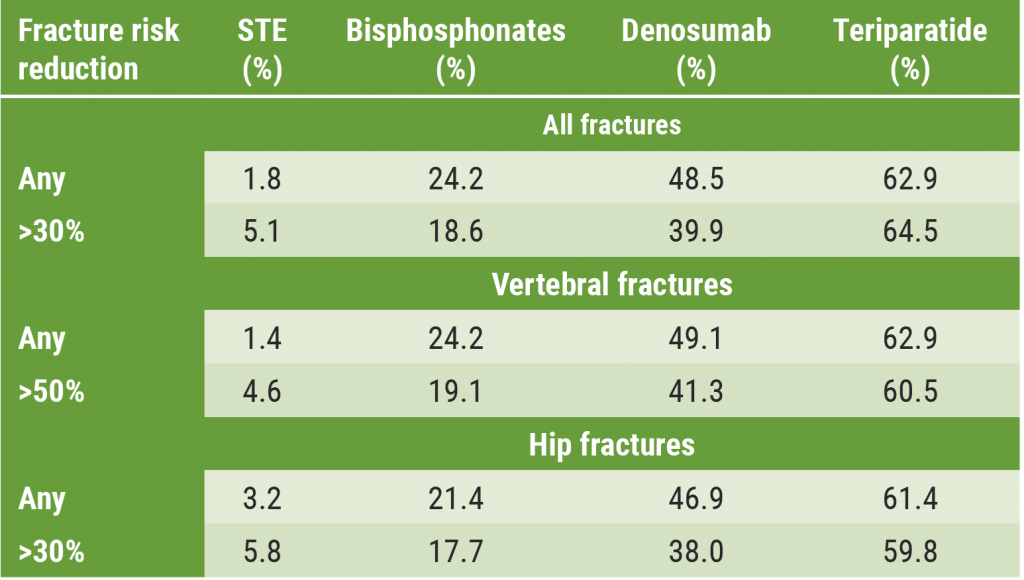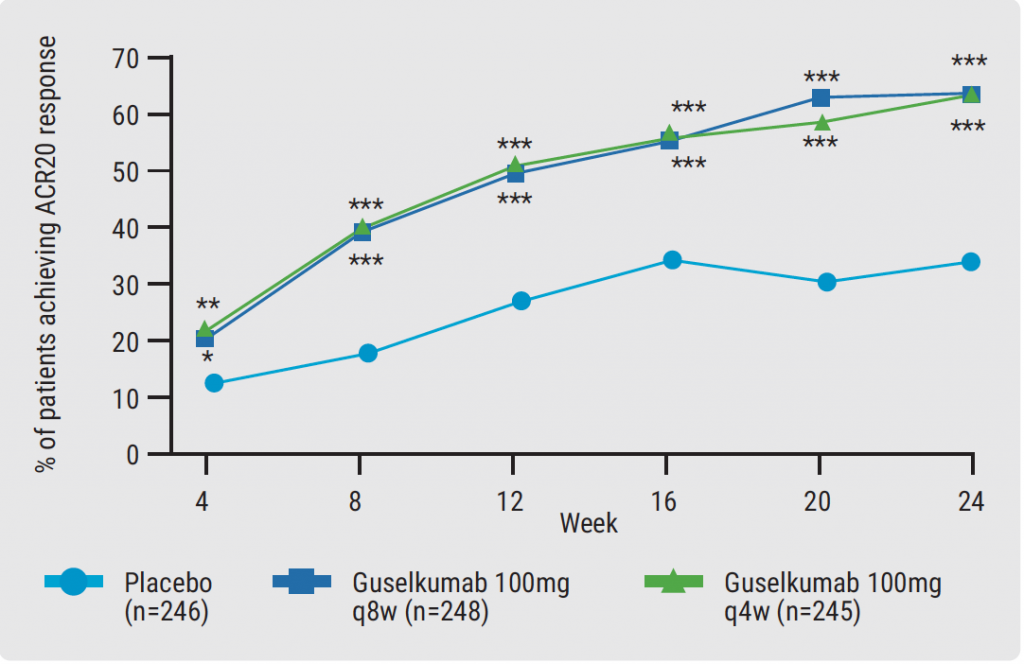https://doi.org/10.55788/32240882
Bone mineral density (BMD) STE is described as the minimally necessary treatment effect on BMD that is predictive of reduced fracture risk with 95% certainty [1]. Dr Giovanni Adami (University of Verona, Italy) explained that the necessary thresholds were recently validated and found different, depending on the type of fracture intended to be reduced in risk [1,2]. The STE estimates for any minimum fracture risk reduction for all, vertebral, hip, and nonvertebral fractures were determined at 1.83%, 1.42%, 3.18%, and 2.13% [2].
The current study used longitudinal information from the DeFRA database between 2012 and 2022 [1]. It identified 1,523 women at high risk of fracture starting therapy with bisphosphonates, 390 with denosumab, and 104 with teriparatide. The mean age of this cohort was 68.2, 10-year major osteoporotic fracture risk was 15.7%, and the median follow-up time was 826 days.
Regarding the rates of patients reaching STE after 2 years of treatment, the proportions varied according to the treatment (see Table), type of fracture, and amount of risk reduction. Regarding all fractures, any risk reduction was achieved by 24.2% (bisphosphonates), 48.5% (denosumab), and 62.9% (teriparatide) at this time point. The respective proportions were 24.4%, 49.1%, and 62.9% for vertebral fractures and 21.4%, 46.9%, and 61.4% for hip fractures, respectively. Kaplan-Meier curves that estimated the likelihood of attaining a T-score higher than -2.5 differed according to treatment. For example, a patient with a T-score of -3.0 at baseline demonstrated a 35% chance of reaching osteopenic levels after 2 years on bisphosphonates but a 54% or 60% chance on denosumab or teriparatide.
“In the long term, if you follow up the patients for over 6 years, you will find that approximately 100% of patients with denosumab and 80% of patients on bisphosphonates reach the STE,” Dr Adami underlined in his conclusion.
Table: Percentage of patients reaching various STEs, stratified by treatment, at 2 years [1]

STE, surrogate threshold effect.
- Adami Proportion of patients reaching the bone mineral density (BMD) surrogate threshold effect (STE) with bisphosphonates, denosumab and teriparatide. OP0242, EULAR 2023, 31 May–3 June, Milan, Italy.
- Eastell R, et J Bone Miner Res. 2022;37:29-35.
Copyright ©2023 Medicom Medical Publishers
Posted on
Previous Article
« Romosozumab: the new option for glucocorticoid-induced osteoporosis with high fracture risk? Next Article
Bimekizumab: high rates of sustained response in PsA »
« Romosozumab: the new option for glucocorticoid-induced osteoporosis with high fracture risk? Next Article
Bimekizumab: high rates of sustained response in PsA »
Table of Contents: EULAR 2023
Featured articles
Late-breaking Oral Abstracts
Selective JAK1/TYK 2 inhibitor effective in patients with difficult-to-treat RA
Novel 2-drug combo improves treatment possibilities for patients with refractory gout
Dazodalibep improves dryness, fatigue, and pain in patients with Sjögren’s syndrome with a high symptom burden
COVID-19: Young adults with auto-immune diseases have different risks than their healthy counterparts
RA in 2023
Poly-refractory RA: not common, but still present
AI almost as successful as experts in predicting early RA
Worse self-management in patients with inflammatory arthritis in the presence of comorbid anxiety or depression
Disease activity-guided dose reduction may be a long-term option for stable RA
Cardiovascular safety of JAK inhibitors: reassuring results from a real-world study
Spondylarthropathies: New Developments
AxSpA: Adalimumab biosimilar equally effective as IL-17 inhibitor in hindering radiographic progression
Vascular inflammation may be characteristic of PsA
Obesity in PsA is increasingly affecting male patients
PsA patients: highest risk of developing NAFLD
What is Hot in Osteoarthritis
Lorecivivint shows long-term benefits for severe knee OA
Methotrexate lowers pain in inflammatory hand OA
Systemic Sclerosis: State of the Art
Targeted DMARDs advantageous in SSc patients with pre-capillary pulmonary hypertension
Osteoporosis: New Data
Drugs for osteoporosis: time to reach fracture risk reduction varies
Romosozumab: the new option for glucocorticoid-induced osteoporosis with high fracture risk?
Best of the Posters
Therapy with biological DMARDs shows no correlation with fracture risk in RA
Basic Science
In vitro and in vivo studies confirm the role of regulatory volume decrease
Related Articles

February 4, 2020
Corticosteroid therapy in GCA: higher platelets – lower relapse rate
© 2024 Medicom Medical Publishers. All rights reserved. Terms and Conditions | Privacy Policy

